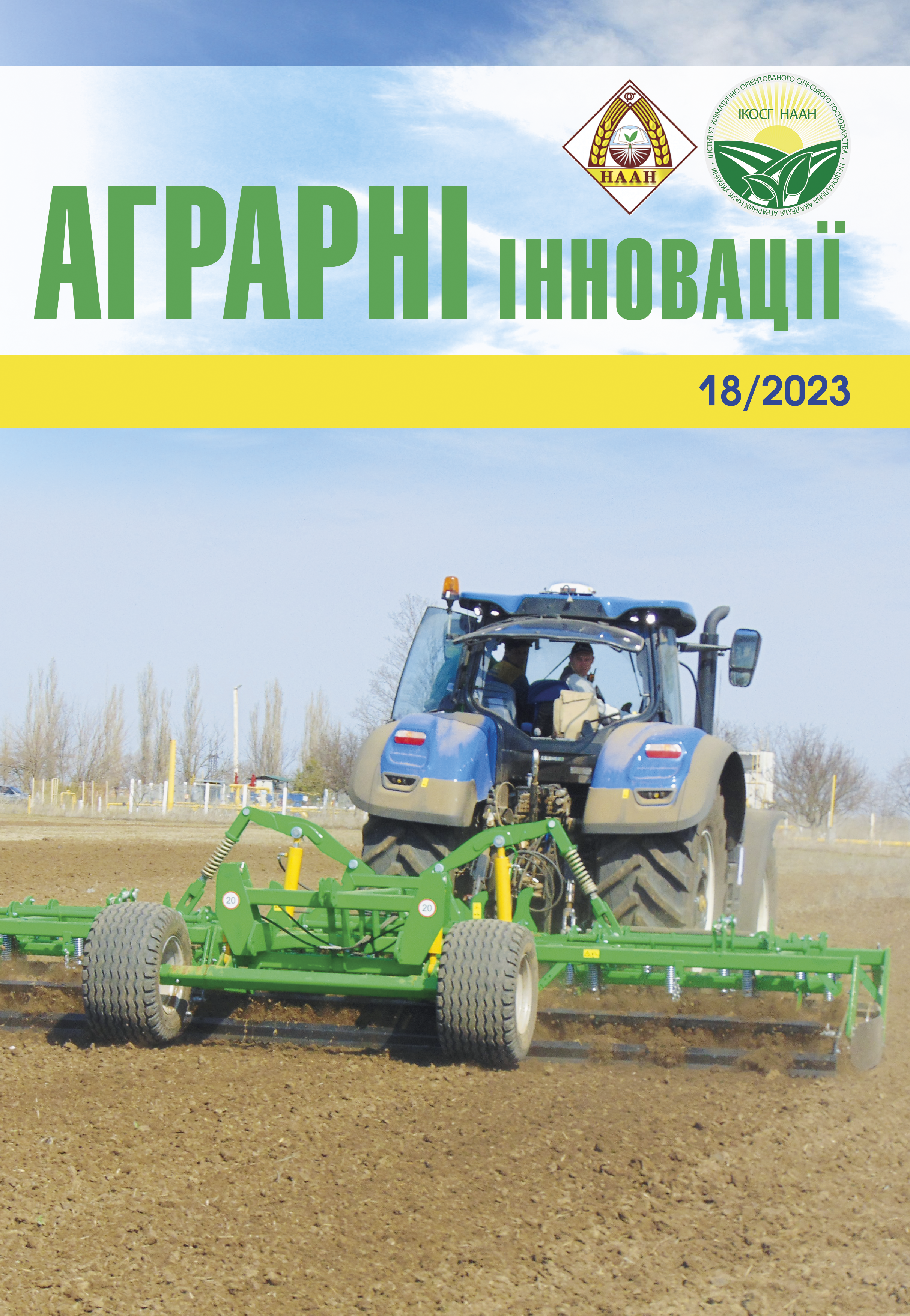EFFICIENCY OF USING COMPLEX MICROFERTILIZERS FOR PRE-SOWING SEED TREATMENT
Abstract
The purpose of our research was to study the effect of pre-sowing seed treatment with complex microfertilizers on the growth and development of soybean plants, the formation of indicators of individual productivity and seed yield in the conditions of the Western Forest-Steppe. Methods. The research was conducted during 2021–2022 on podzolized, medium loamy black soil of the Western Forest-Steppe of Ukraine. The experiment is twofactor, factor A – soybean varieties, factor B – pre-sowing seed treatment. The experiment was replicated three times. Plots were arranged systematically. The following research methods were used in the research: field (visual and phenological observations of the growth and development of soybean plants); statistical (statistical processing of research results). Results. According to the results of the research, it was found that pre-sowing treatment of seeds with complex microfertilizers had a positive effect on field germination, thereby increasing the density of soybean plants in the Siverka variety by 3.5–5.9%, in the Titan variety – by 3.5–5.8% compared to the control. At the same time, the treatment of seeds before sowing with complex microfertilizers led to an improvement in the individual productivity of soybean plants. In particular, in the Siverka variety, the number of beans per plant increased by 14.1–25.5%, the number of seeds per plant by 21.0–31.5%, the weight of seeds per plant by 19.4–29.2%, and the weight of 1000 seeds by 3.2–7.7% compared to the control. In the Titan variety, the number of beans and seeds increased by 9.0–20.0% and 10.7–20.6%, respectively, and the weight of seeds and 1000 seeds by 10.9–26.6% and 1.9–7.7%. As a result, all the variants of pre-sowing seed treatment that were studied provided a significant (in the Siverka variety by 0.15– 0.21 t/ha or 5.6–7.8%, in the Titan variety by 0.18–0.23 t/ha or 6.3–8.0%) increase in seed yield compared to the control. Conclusions. The greatest increase in individual productivity and yield was obtained with pre-sowing treatment of soybean seeds with the concentrated fertilizer Seed Chemist, where, compared to the control, in the Siverka variety the number of beans per 1 plant increased by 25.5%, the number of seeds per 1 plant – by 31.5%, the weight of seeds per 1 plant – by 29.2% and the weight of 1000 seeds – by 7.7%. In the Titan variety, the number of beans and seeds increased by 20.0% and 20.6%, respectively, and the weight of seeds and 1000 seeds by 26.6% and 7.7%. The increase in seed yield was 7.8% in the Siverka soybean variety and 8.0% in the Titan variety.
References
2. Білявська Л.Г., Білявський Ю.В., Діянова А.О., Мирний М.В. Сорти сої для Степу та Лісостепу України. Вісник ПДАА. 2021. № 1. С. 135–140. doi: 10.31210/visnyk2021.01.16
3. Бикін А.В., Генгало Н.О. Ефективність застосування добрив і гумату калію за вирощування сої на чорноземі типовому мало гумусному. Науковий вісник Національного університету біоресурсів і природокористування України. Серія «Агрономія». 2011. Вип. 162, ч. 2. С. 137–144.
4. Душко П.М. Оцінювання удобрень сої в технології її вирощування за адаптивним потенціалом. Агроекологічний журнал. 2017. № 2. С. 205–210. http://doi.org/10.333730/2077-4893.2.2017.220307
5. Каленська С. М., Новицька Н. В. Ефективність нанопрепаратів у технології вирощування сої. Рослинництво та ґрунтознавство. 2020. Том 11 № 3. С. 7–21. DOI: https://dx.doi.org/10.31548/ agr2020.03.07
6. Кавецький С.В. Особливості живлення та удобрення сої. Посібник українського хлібороба. 2013. Т. 2. С. 92–94.
7. Кобак С., Колісник С., Сереветник О., Чорна В. Мінеральне живлення сої. The Ukrainian Farmer. 2017. № 4. С. 112–116.
8. Мазур О. В. Адаптивна цінність сортів сої за різних умов вирощування. Сільське господарство та лісівництво. 2022. № 27. С. 74–92. DOI: 10.37128/2707-5826-2022-4-7
9. Міленко О. Г., Соломон Ю. В. Ефективність застосування мікродобрив для обробки посівного матеріалу сої. Таврійський науковий вісник. 2022. Вип. № 126. С. 85–91. https://doi. org/10.32851/2226-0099.2022.126.12
10. Новохацький М., Бондаренко О., Майданович Н. Ефективність застосування нанодисперсного порошку оксиду заліза у вирощуванні ячменю ярого та сої. Техніко-технологічні аспекти розвитку та випробування нової техніки і технологій для сільського господарства України. Вип. 28 (42). С. 192–202. http://dx.doi.org/10.31473/2305-5987-2021-1-28(42)-16
11. Панасюк Р. Вирощування нових скоростиглих сортів сої української селекції в умовах Західного Лісостепу. Вісник Львівського національного аграрного університету. Серія «Агрономія». 2020. № 24. С. 89–92. https://doi.org/10.31734/agronomy2020.01.089
12. Рожков А.О., Пузік В.К., Каленська С.М. та ін. Дослідна справа в агрономії: навчальний посібник. Книга 1 – Теоретичні аспекти дослідної справи. Харків: «Майдан», 2016. 314 с.
13. Рожков А.О., Пузік В.К., Каленська С.М. та ін. Дослідна справа в агрономії: навчальний посібник. Книга 2 – Статистична обробка результатів досліджень. Харків: «Майдан», 2016. 340 с.
14. Чумак А. Бор у вирощуванні сої. Пропозиція. 2017. № 6. С. 88–89.
15. Чумак А., Довгаюк-Семенюк М. Молібден та соя: можливості й проблеми. Пропозиція. 2017. № 2. С. 98–102.
16. Шовкова О.В., Коротич Є.В. Ефективність мікродобрив для передпосівної обробки насіння сої. Вісник ПДАА. 2021. № 4. С. 98–102. doi: 10.31210/ visnyk2021.04.12






